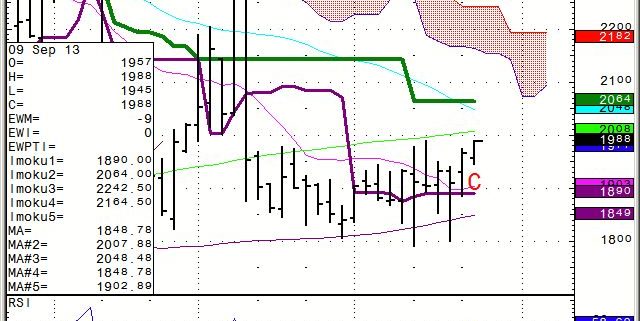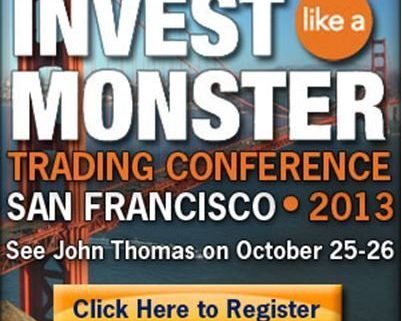While the Diary of a Mad Hedge Fund Trader focuses on investment over a one week to six-month time frame, Mad Day Trader, provided by Jim Parker, will exploit money-making opportunities over a brief ten minute to three day window. It is ideally suited for day traders, but can also be used by long-term investors to improve market timing for entry and exit points.
As a potentially profitable opportunity presents itself, John will send you an alert with specific trade information as to what should be bought, when to buy it, and at what price. Read more
While the Diary of a Mad Hedge Fund Trader focuses on investment over a one week to six-month time frame, Mad Day Trader, provided by Jim Parker, will exploit money-making opportunities over a brief ten minute to three day window. It is ideally suited for day traders, but can also be used by long-term investors to improve market timing for entry and exit points.
As a potentially profitable opportunity presents itself, John will send you an alert with specific trade information as to what should be bought, when to buy it, and at what price. This is your chance to ?look over? John Thomas? shoulder as he gives you unparalleled insight on major world financial trends BEFORE they happen. Read more
While the Diary of a Mad Hedge Fund Trader focuses on investment over a one week to six-month time frame, Mad Day Trader, provided by Jim Parker, will exploit money-making opportunities over a brief ten minute to three day window. It is ideally suited for day traders, but can also be used by long-term investors to improve market timing for entry and exit points.
Global Market Comments
September 9, 2013
Fiat Lux
Featured Trade:
(JOIN THE INVEST LIKE A MONSTER SAN FRANCISCO TRADING CONFERENCE)
(SEPTEMBER 11 GLOBAL STRATEGY WEBINAR),
(THE EMERGING ?BUY? ON EMERGING MARKETS),
(EWW), (EZA), (IDX), (THD), (EWM), (EPHE), (GXG), (ECH)
iShares MSCI Mexico Capped (EWW)
iShares MSCI South Africa Index (EZA)
Market Vectors Indonesia Index ETF (IDX)
iShares MSCI Thailand Capped Invstbl Mkt (THD)
iShares MSCI Malaysia (EWM)
iShares MSCI Philippines Invstb Mkt Idx (EPHE)
Global X FTSE Colombia 20 ETF (GXG)
iShares MSCI Chile Capped (ECH)
I am pleased to announce that I will be participating in the Invest Like a Monster Trading Conference in San Francisco during October 25-26. The two-day event brings together experts from across the financial landscape who will improve your understanding of markets by a quantum leap and measurably boost your own personal trading performance.
Tickets are available for a bargain $399. If you buy the premium $499 package you will be invited to the Friday 6:00 pm VIP cocktail reception, where you will meet luminaries from the trading world, such as Trademonster?s Jon and Pete Najarian, Guy Adami, Jeff Mackey, and of course, myself, John Thomas, the Mad Hedge Fund Trader. All in all, it is great value for the money, and I?ll personally throw in a ride on the City by the Bay?s storied cable cars for free.
Jon Najarian is the founder of OptionMonster, which offers clients a series of custom crafted computer algorithms that give a crucial edge when trading the market. Called Heat Seeker ?, it monitors no less than 180,000 trades a second to give an early warning of large trades that are about to hit the stock, options, and futures markets.
To give you an idea of how much data this is, think of downloading the entire contents of the Library of Congress, about 20 terabytes of data, every 30 minutes. His firm maintains a 10 gigabyte per second conduit that transfers data at 6,000 times the speed of a T-1 line, the fastest such pipe in the civilian world. Jon?s team then distills this ocean of data on his website into the top movers of the day. ?As with the NFL,? says Jon, ?you can?t defend against speed.?
The system catches big hedge funds, pension funds, and mutual funds shifting large positions, giving subscribers a peek at the bullish or bearish tilt of the market. It also offers accurate predictions of imminent moves in single stock and index volatility.
Jon started his career as a linebacker for the Chicago Bears, and I can personally attest that he still has a handshake that?s like a steel vice grip. Maybe it was his brute strength that enabled him to work as a pit trader on the Chicago Board of Options Exchange for 22 years, where he was known by his floor call letters of ?DRJ.? He formed Mercury Trading in 1989 and then sold it to the mega hedge fund, Citadel, in 2004.
Jon developed his patented algorithms for Heat Seeker? with his brother Pete, another NFL player (Tampa Bay Buccaneers and the Minnesota Vikings), who like Jon, is a regular face in the financial media.
In order to register for the conference, please click here. There you will find the conference agenda, bios of the speakers, and a picture of my own ugly mug. I look forward to seeing you there.
Cling! Cling!
 Jon Najarian
Jon Najarian
No asset class has been beaten more severely this year than emerging markets. Since the March, 2011 high, the iShares MSCI Emerging Market ETF (EEM) has plunged from $48 to $35.80, a loss of 25%. Individual markets have fared far worse. The Market Vectors Indonesia ETF (IDX) has taken a 39% haircut, while the Powershares India Portfolio ETF (PIN) has cratered by 46%.
It wasn?t supposed to be like this. These countries boast GDP growth rates of two to four times those found in the developed world. Many, like Chile (ECH) and Indonesia (IDX) are endowed with abundant natural resources. India (PIN) offers one of the world?s most attractive demographic pyramids, a precursor to stable long term growth.
The Philippines (EPHE) boasts a great, low waged, educated labor force. It is no accident that to subscribe to the San Francisco Chronicle your call gets directed to an obscure location 200 miles south of Manila, where call center workers live well on $2,000 a year.
You can blame China for starting the malaise. The Middle Kingdom is the largest customer for many of these countries, and successful efforts to throttle back the economy to control runaway home price inflation have spilled far beyond its borders. Since 2007, China?s economy has slowed from a near 14% annual growth rate to a probable 7%. This is a rate not to be sneezed at, but it is still quite a hit. Weak emerging economies then slow China further, creating a vicious negative feedback loop.
China isn?t the only problem. Most emerging nations are highly dependent on imported energy, and are in effect shorts on oil. So when Middle Eastern turmoil drives Texas tea up 28% over the past five months, as it has, balance of payments bleed. This has pummeled their currencies, boosting the local cost of fuel even further. In some countries gasoline costs have soared by more than 50% since the spring. This is terrible for their economies.
The big surprise is how much Ben Bernanke?s ?taper? thoughts are pounding the emerging markets. Much of the excess cash that the Federal Reserve has created over the past five years has poured into the emerging space, boosting share prices and ETF?s to heady heights. Cut off that supply, even by a piddling $5 billion a month, and everyone tries to leave the party at the same time. The price action has been reminiscent of the proverbial flash fire in the movie theater.
Excess liquidity has in fact turned the emerging markets into ?reach for yield? assets, much like master limited partnerships, sovereign debt, junk bonds, municipal bonds, and REIT?s. All of these asset classes have held hands jumping over the cliff since April, when the ?taper? talk began. When investors take inordinate risks for small, incremental improvements in returns, it always ends in tears.
Once emerging markets started going down, all the dirty laundry came out. Tales of corruption have always been endemic to the region. China has started arresting foreign drug company executives for bribery, a classic case of the pot calling the kettle black. The human rights records of several are less than sterling. Having spent time in jail in some of these places because of what I wrote, I more than sympathize.
What?s worse, some of the emerging fundamentals have deteriorated. Once, you bought these countries because they had little debt, a legacy of dismal credit ratings in the seventies and eighties. What did the Fed?s easy money policies accomplish here? Rising debt levels, both at the national and corporate level. Worst of all, some countries have been borrowing from abroad to subsidize fuel prices to lessen the recent price spike. That weakens national finances at an exponential rate.
It all adds up to a perfect storm for emerging markets. Think of them as a short oil/short dollar/long junk play. Ouch! With the way they have been trading, you?d think their largest export was venereal disease!
Which is all why I am starting to get interested. For many years, emerging market companies sold at large premiums to American ones. They now sell at a 35% discount. The long-term bull case is still valid. Watch the bond market. If it rallies hard in the wake of the Fed?s taper decision, as I expect, then it will be off to the races for emerging markets once again.
But it won?t be your father?s emerging bull market. Forget about the BRIC?s (Brazil, Russia, India, China), which are last year?s story. Just mindlessly buying the (EEM) won?t work anymore either. This is no longer an index play.
In the next cycle single country picks will be the name of the game. What?s on my short list? Mexico (EWW), South Africa (EZA), Indonesia (IDX), Thailand (THD), Malaysia (EWM), the Philippines (EPHE), Columbia (GXG), and Chile (ECH). Industry selection will also be important, with a move away from export industries towards domestic consumption called for.
Maybe it?s time to add Thailand to my short list of potential vacation destinations?
 Time to Look at Emerging Markets?
Time to Look at Emerging Markets?
As a potentially profitable opportunity presents itself, John will send you an alert with specific trade information as to what should be bought, when to buy it, and at what price. Read more
Legal Disclaimer
There is a very high degree of risk involved in trading. Past results are not indicative of future returns. MadHedgeFundTrader.com and all individuals affiliated with this site assume no responsibilities for your trading and investment results. The indicators, strategies, columns, articles and all other features are for educational purposes only and should not be construed as investment advice. Information for futures trading observations are obtained from sources believed to be reliable, but we do not warrant its completeness or accuracy, or warrant any results from the use of the information. Your use of the trading observations is entirely at your own risk and it is your sole responsibility to evaluate the accuracy, completeness and usefulness of the information. You must assess the risk of any trade with your broker and make your own independent decisions regarding any securities mentioned herein. Affiliates of MadHedgeFundTrader.com may have a position or effect transactions in the securities described herein (or options thereon) and/or otherwise employ trading strategies that may be consistent or inconsistent with the provided strategies.















